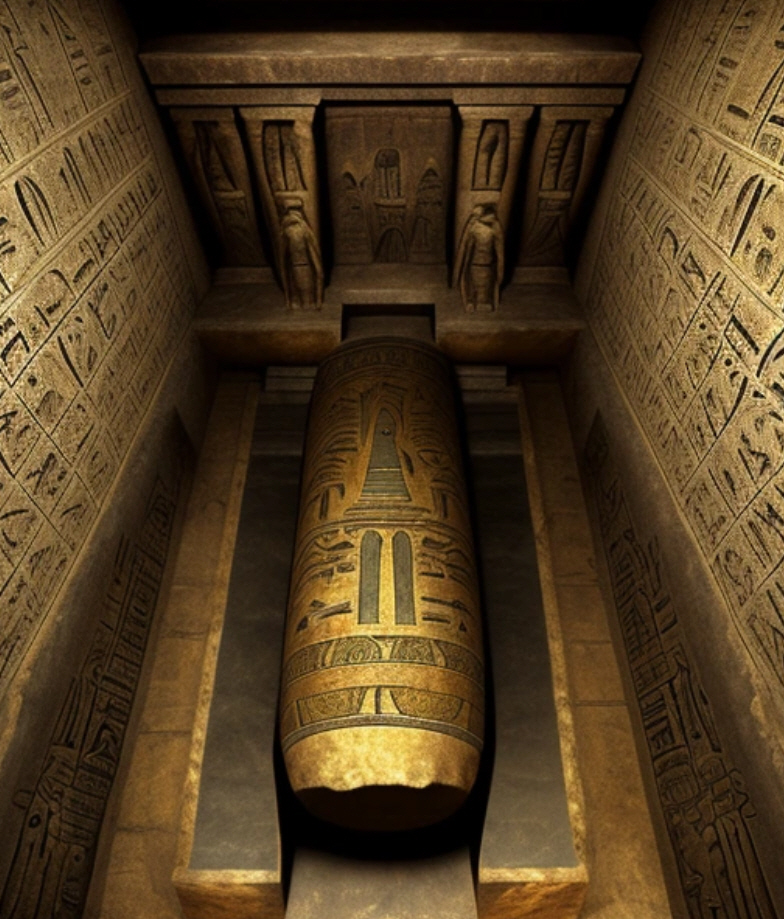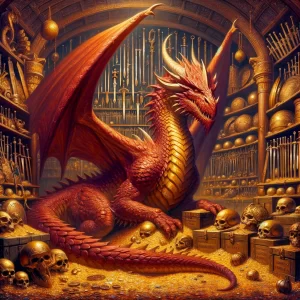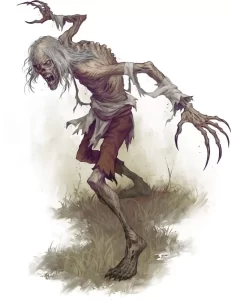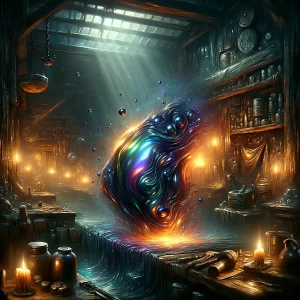
Mummies
In the forsaken corners of the world where the air is parched and life scarcely clings, a chilling practice thrives in the clutches of those entranced by the macabre. The orchestrators of this dark art, cloaked in mystery, revel in the gruesome transformation of the deceased, seeking to stretch the boundaries of mortality to their very limits.
In desolate deserts and atop barren mountains, where the elements conspire to preserve the dead, these practitioners of the forbidden plunge deep into the abyss of death's secrets. Through the twisted corridors of time, priests and their sinister acolytes toil in the darkness, their hands stained with the remnants of life, orchestrating a symphony of horrors that breathes malevolence into the very essence of the departed.
Over the span of grueling months, these malevolent artisans meticulously drain every vestige of life force from the corpses, leaving behind grotesque husks ready to harbor an impending darkness. With cold precision, they extract the vital organs, safeguarding them in sepulchres of desecration, as they prepare to usher in an existence that defies the sanctity of death.
Each body is treated as a canvas, onto which horrors unknown are etched with sacred oils and resins that sear and meld flesh and nightmare together. This unholy ceremony reaches its climax as the corpse, now transformed into a vessel of dread, is interred in its final resting place, a tomb that holds not peace, but a restless, insatiable hunger for the life it once knew.
In the quietude that follows, a monstrous perversion of life and death takes hold, birthing entities neither living nor dead, but something far more terrifying. Unhindered by mortal constraints, these abominations lurk in the shadows, testimonies of a ritual gone horribly awry, where the line between man and monster blurs and descends into the realms of the unimaginable.
In the annals of dark folklore, the heinous curse of the mummies stands as a chilling testament to mankind's brush with the nefarious forces that lurk within the depths of ancient tombs. It is whispered amongst hushed circles that to disturb the slumber of these ghastly entities is to beckon a fate most vile, a relentless onslaught of malevolence that seeks to consume both body and soul.
At the very crux of this diabolical phenomenon lies the malignant touch of the mummy, a caress so malefic that it imbues its victims with a relentless necrosis, a wasting disease that ravages flesh and bone until nothing remains but a desiccated husk, a grim reminder of mortality's fragility. Those ensnared in this ghastly affliction find themselves spiraling into a pit of despair, their very essence crumbling to dust in a cruel mockery of their former selves.
Yet, the horrors do not end with a mere touch. The mummy's curse, a malevolent force that inflicts a relentless tide of misfortunes upon those who dare desecrate their resting place, is an entity of its own. A dark and ironic humor seems to guide its hand, as it engineers a series of cataclysmic events that are grotesquely tailored to mirror the trespassers' actions, or even moments from the mummy's own tragic narrative.
The whispers tell of a curse that extends its cold grasp beyond just the initial violators, ensnaring friends and loved ones in a web of darkness that knows no bounds. Its cruelty manifests in countless forms: dreams invaded by nightmarish apparitions, a sudden onset of financial catastrophes, bodily harm that maims and degrades, and in the most sinister of cases, the icy hand of death itself.
To add fuel to the fires of dread, rumors circulate that the mere act of touching artifacts pilfered from these accursed tombs can invoke the wrath of the mummies, binding the foolish individuals to a fate marked by agony and despair. It seems that the mummies, in their eternal rest, have crafted a darkly poetic form of vengeance, a grim tapestry of retribution that awaits any who would dare to violate the sanctity of their sepulchral domain.
Origins of Mummies
In the shadowy recesses of history, a dark and foreboding process twists the sacred ritual of mummification into a grotesque parody, spawning entities consumed by malevolence and undying rage. This aberration in the rites, sometimes guided by the insidious influences of demonic cults or infernal texts mistaken for divine scripture, binds the tormented spirit of the deceased to a plane of unspeakable anguish, stripping it of the celestial grandeur it was promised.
These dark practices, embraced willingly by cultures submerged in demon worship or beliefs in the brutal purification of the soul through suffering, condemn the spirit to an eternity of agony, entrapped within the confines of a desecrated corpse, longing for release yet denied the peace of true death.
At the ritual's culmination, the body finds its final resting place within a sarcophagus, ensnared by a potent magical seal that stands as a bulwark against unauthorized resurrection. This safeguard, which might manifest as a breakable tablet or a curse awakened by the theft of tomb artifacts or utterance of the mummy's name, harbors a sinister secret: a mechanism to unleash the reanimated mummy upon those who dare violate its sanctuary.

Upon the seal's breach, the tomb erupts into a nexus of dark energies, and the mummy rises, now a vessel for a spirit driven to madness by aeons of torment in a demonic realm or replaced by a demonic entity that feasted upon the original soul. This awakened horror, its essence aflame with rage, embarks on a relentless hunt, vowing to obliterate those responsible for its desecration.
Integral to this dark ceremony is the extraction and separate preservation of key organs, a grotesque mimicry of the traditional mummification practice. These organs, housed in vessels of intricate artistry, act as anchors binding the mummy to the world of the living. In particular, the heart serves as a dark core of existence, a cruel mockery of a lich's phylactery, granting the mummy an unholy persistence that denies it the release of death.
Unlike the phylactery, which demands a steady flow of sacrificed souls to sustain, these cursed relics grant the mummy an undying existence devoid of any consent or input from the entrapped entity. This creates a horrifying paradox, where the enraged mummy finds itself ensnared in an eternal cycle of death and rebirth, its fury fueled by an inability to find release in the sweet embrace of oblivion.
Mummies Environment
In the recesses of time and dust, where opulence meets the macabre, lie the tombs of the mummies, enigmatic mausoleums harboring remnants of power and grandeur from eras long past. Predominantly crafted for the affluent and exalted, the construction of a mummy's sepulchral abode reflects a society deeply entrenched in the veneration of the afterlife, a culture willing to invest immense resources to safeguard the journey of their deceased to the realms beyond.
Treading through these monumental necropoli, one is met with a labyrinthine layout, an enigmatic network of chambers meticulously arranged to house an assortment of grave goods, a testament to the individual's earthly might and piety. While a majority of these sanctuaries prefer to wear a facade of modesty, silently guarding their golden treasures within, others brazenly declare their splendor, standing as towering edifices or vast necropolises, fortified strongholds against the greed of grave robbers.

Once within, an intruder might find rooms dedicated to martial prowess, filled with an array of favored weapons, or chambers graced by statues of deities, a solemn nod to the interred's devotion. Yet, these treasures pale in comparison to the tomb's true protectors: an army of mummified servants, companions, and even beloved pets, who line the hushed halls in silent vigil, their willingness to serve in death a mystery lost to the sands of time.
Upon the desecration of these sacred grounds, the master of the tomb awakens, a force of undying rage and dominion. Granted mastery over its realm, the mummy possesses the power to commandeer the very contents of its burial chamber, summoning forth an army of lesser mummies, perhaps unwilling yet bound to serve in this dark afterlife. Their numbers bolstered by animated effigies, from humble wooden figurines to gargantuan granite deities, ready to unleash their wrath upon those who dared to defile their sanctuary.
Navigating through these sepulchral mazes, one might encounter an array of intricate traps, designed both to ensnare the greedy and deter the innocent. Some mechanisms seek to imprison intruders within the tomb's eerie confines, denying them retreat, while others seemingly bear a semblance of mercy, aimed at warding off potential violators before they breach the sanctity of the sacred seal.
In this realm where extravagance meets the grotesque, where death intertwines with undying loyalty, the mummy's tomb stands as an eerie monument to a civilization's reverence for the afterlife, a dark mirror reflecting their beliefs, their grandeur, and their fears.
Mummies Combat Tactics
In the shadows of ancient realms, where time seems to stand still, the mummies stand as an eerie testament to the brilliance they harboured in their past lives. Within the confines of their haunting tombs, these beings retain the sharp intellect and finesse they once flourished with in the realm of the living. A warrior of cunning strategies does not shed his brilliance with mortality, fighting with an even more terrifying precision, a dance of death steeped in ancient battle tactics. Meanwhile, a sage well-versed in the mystic arts in their lifetime would summon arcane energies with the same, if not heightened, dexterity, weaving spells that reverberate with the echoes of a time long gone.
In stark contrast, their entombed servants, lesser beings resurrected as guardians, may not boast the same adeptness. Their skills might be dulled by the sands of time, yet a formidable force brews within them, a relentless drive that propels them to fight with an undying loyalty, answering the relentless call of their master without a moment's hesitation.
At the core of a mummy's undying wrath is a focus that transcends death - a vehement ire that narrows unerringly on the individual responsible for breaking the sacred seal of its resting place. A transgression of such magnitude kindles a vengeful flame that cannot be easily extinguished. With a dark promise of death, the mummy seeks the desecrator, a relentless pursuit that only intensifies with the fall of each accomplice.
The rage of a mummy knows no bounds, and in its wake, a dark curse unfolds, capable of ensnaring not only those who have directly offended but potentially extending its malevolent grasp to encompass their families, even threatening to engulf anyone unfortunate enough to cross paths with the cursed individuals. A chain reaction of darkness and doom, orchestrated by a being unwilling to rest whilst its sanctum stands violated.
Yet, amidst the chaos, there exists a level of self-preservation. These undying masters harbor no intentions of meeting a second end amidst their vengeance-fueled onslaught. When faced with potential obliteration, they reveal an uncanny ability to strategize, making a tactical withdrawal to sanctuaries unknown, their wrath momentarily simmering in the shadows. In the silence that follows, they concoct newer, darker plans, ready to unleash a reign of terror that would see their vengeance fulfilled, painting a grim tapestry of vengeance that transcends time itself.
Read about Dungeons and Dragons Revenants






